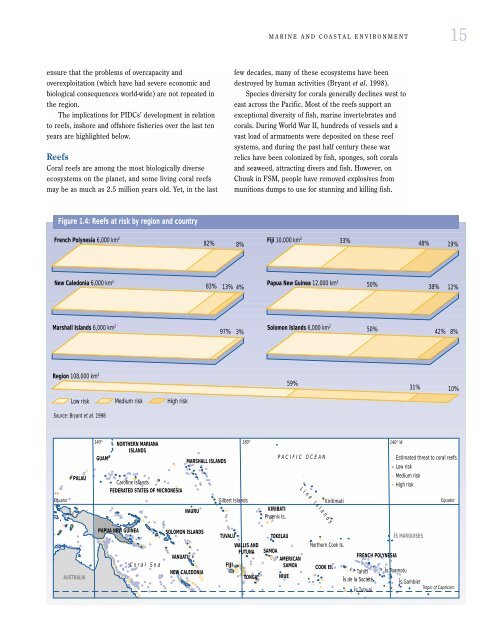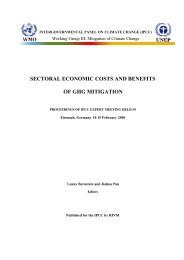Pacific Islands Environment Outlook - UNEP
Pacific Islands Environment Outlook - UNEP
Pacific Islands Environment Outlook - UNEP
You also want an ePaper? Increase the reach of your titles
YUMPU automatically turns print PDFs into web optimized ePapers that Google loves.
MARINE AND COASTAL ENVIRONMENT 15<br />
ensure that the problems of overcapacity and<br />
overexploitation (which have had severe economic and<br />
biological consequences world-wide) are not repeated in<br />
the region.<br />
The implications for PIDCs’ development in relation<br />
to reefs, inshore and offshore fisheries over the last ten<br />
years are highlighted below.<br />
Reefs<br />
Coral reefs are among the most biologically diverse<br />
ecosystems on the planet, and some living coral reefs<br />
may be as much as 2.5 million years old. Yet, in the last<br />
few decades, many of these ecosystems have been<br />
destroyed by human activities (Bryant et al. 1998).<br />
Species diversity for corals generally declines west to<br />
east across the <strong>Pacific</strong>. Most of the reefs support an<br />
exceptional diversity of fish, marine invertebrates and<br />
corals. During World War II, hundreds of vessels and a<br />
vast load of armaments were deposited on these reef<br />
systems, and during the past half century these war<br />
relics have been colonized by fish, sponges, soft corals<br />
and seaweed, attracting divers and fish. However, on<br />
Chuuk in FSM, people have removed explosives from<br />
munitions dumps to use for stunning and killing fish.<br />
Figure 1.4: Reefs at risk by region and country<br />
French Polynesia 6,000 km 2 82% 8%<br />
Fiji 10,000 km 2 33%<br />
48%<br />
19%<br />
New Caledonia 6,000 km 2 83% 13% 4%<br />
Papua New Guinea 12,000 km 2 50%<br />
38%<br />
12%<br />
Marshall <strong>Islands</strong> 6,000 km 2 97% 3%<br />
Solomon <strong>Islands</strong> 6,000 km 2 50% 42% 8%<br />
Region 108,000 km 2<br />
59%<br />
31%<br />
10%<br />
Low risk Medium risk High risk<br />
Source: Bryant et al. 1998<br />
PALAU<br />
140°<br />
GUAM<br />
NORTHERN MARIANA<br />
ISLANDS<br />
Caroline <strong>Islands</strong><br />
FEDERATED STATES OF MICRONESIA<br />
MARSHALL ISLANDS<br />
180°<br />
PACIFIC OCEAN<br />
L i n e<br />
140° W<br />
Estimated threat to coral reefs<br />
Low risk<br />
Medium risk<br />
High risk<br />
Equator<br />
NAURU<br />
Gilbert <strong>Islands</strong><br />
KIRIBATI<br />
Phoenix Is.<br />
I s l a n<br />
Kiritimati<br />
d s<br />
Equator<br />
AUSTRALIA<br />
PAPUA NEW GUINEA<br />
Coral Sea<br />
SOLOMON ISLANDS<br />
VANUATU<br />
NEW CALEDONIA<br />
TUVALU<br />
FIJI<br />
WALLIS AND<br />
FUTUNA<br />
TONGA<br />
SAMOA<br />
TOKELAU<br />
AMERICAN<br />
SAMOA<br />
NIUE<br />
Northern Cook Is.<br />
COOK IS.<br />
FRENCH POLYNESIA<br />
Tahiti<br />
Îs.de la Société<br />
Îs.Tubuai<br />
ÎS MARQUISES<br />
Îs.Tuamotu<br />
Îs.Gambier<br />
Tropic of Capricorn

















